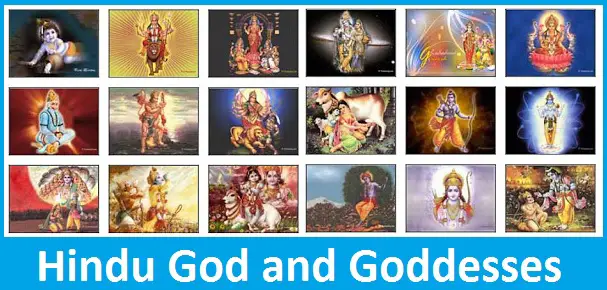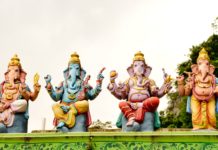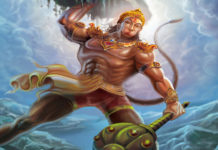Hinduism is a pantheistic religion. They respect Gods and equate them to the whole of the universe. They believe that God is the supreme one and he is the source of endless power. Hindu Gods and Goddesses are known as the absolute and formless reality which gives men the most-needed mental strength at the very necessary moments. In spite of being pantheistic, Hindu religion is also polytheistic. It is populated with many myriad Gods and Goddesses who symbolizes the fact of one true God. This allows every individual person to worship Gods in infinite number of ways which differs according to community, family traditions, regional practices and other issues. Here is the list of some Gods and Goddesses in Hinduism:
Brahma: Among the Hindu trinity which includes Brahma, Vishnu, Shiva, Brahma is the creator. Brahma is believed to be the creator because he periodically creates every elements of the universe. Brahma grew in a lotus and he came out from the navel of Vishnu. The daily alteration of daily basis day and night is attributed to the act of Brahma. He is the son of God, preferably Prajapati. In order to help him in creating the universe, he gave birth to 11 forefathers called ‘Prajapatis’ and seven great sages named ‘Saptarshi’. Brahma is represented as four heads, four arms and red skin. He holds a water-pot, spoon, Vedas, a rosary or a lotus unlike the other Hindu Gods and Goddesses. He sits on a lotus and he possesses the ability to separate milk from the mixture of water and milk.
Vishnu: Vishnu is the symbol of mercy and goodness in the Hindu religion. He maintains the harmony and order of the universe, created by Brahma. He is worshiped in several forms and avatars. Vishnu holds conch, disc, club and a lotus in his four hands and rests on a coiled serpent Shesha. In Vashnavism, he is the Lord of the universe. The Vedas explains him as a solar deity. The most recognized incarnations of Vishnu are Parasurama, Ram, Krishna and Buddha. His sky blue body color denotes his cosmic dimensions and the contact with Hindu Gods and Goddesses of rain and thunder.
Shiva: According to the Hindu mythology, Shiva is known as the destroyer of the universe. He destroyed everything in order to renew each one of the systems and cycles of the earth. He has three eyes with an ash-smeared body and is always fascinated by his followers for his unique appearance. He is responsible for the change in the form of death and destruction. His dance ‘Tandav Nritya’ is actually a symbol of the battle for war against ignorance, lies which helps to free his followers from sufferings. It is known that all that has a beginning must have an ending too. The destruction power of Shiva is actually a purifying form of removing ego, ignorance, intolerance from the earth.
Ganesha: Ganesha is Shiva’s first son and also known as Ganapati. Ganesha became the lord of all existing things after winning a contest against his brother Kartika. He has a very special place in the Hindus’ heart among all Hindu Gods and Goddesses because they think him as the supreme power for removing obstacles. Ganesha rides a rat representing the demon of impertinence and vanity. He carries a rope to carry devotees to the way of truth and rope to cut their attachments and a sweet dessert ball-laddoo to serve his spiritual followers. His fourth hand’s palm is extended to bless his devotees.
Annapoorna: Devi Annapurna is the goddess of food and kitchen. She is the incarnation of Goddess Parvati, wife of Shiva. She has the power to supply food to unlimited needy people. ‘Anna’ means food and ‘poorna’ means completely filled in Sanskrit. The worship of Goddess Annapoorna was started when the Earth was in a huge danger due to lack of food. When Lord Brahma and Vishnu asked for help to Lord Shiva, he summoned Goddess Annapoorna and begged for food. Finally, Devi Annapoorna became the savior of the hungry people. Annapoorna is the symbol of divine nourishing care among the Hindu Gods and Goddesses.
Saraswati: Saraswati is the Goddess of learning, music and other creative arts in Hindu religion. She is known as the mother of Vedas and the source of recreation of Brahma’s intelligence. People believe lost Vedic river as her origin. Students and artists worship her to perform well in their fields. She is dressed in white sari, holding mala and a palm leaf scroll which indicate knowledge. Saraswati usually rides a swan while playing music on veena. The Vilma Vashi Temple in Dilwara is one of the famous temples dedicated to Saraswati. Gayatri is also an important incarnation of Saraswati among Hindu Goddesses.
Durga: Durga is the goddess of power and strength and incarnation of Mother Goddess and considered to be the most supreme of Hindu Gods and Goddesses. She is known as Mahishasuramardini which means the destroyer of all the evil power which exists in the universe. To destroy evil demons, the Gods offered their radiation and created Durga, the supreme source of all divine powers. The word ‘Durga’ means invincible in Sanskrit. She is the goddess of truth, self-realization, purity, knowledge. In India, she is worshiped in the autumn season along with her children and it is considered as the most famous religious occasion in India.
There are also many interesting stories about Hindu Gods and Goddesses enlisted in the Hindu mythology. India is known as the most religious diverse nations of the world where religion is the central force in the Indians’ lives. 80% of the people are Hindus in India and are known as the oldest religion system of the world. The Hindu scriptures describe Hindu Gods and Goddesses as all-knowing and all-powerful. They always shower their mercy, grace, love and blessings to their followers and is the symbol of universal beauty.




[…] is an Indian religion. Shiva is a member of the Trimurti, the trinity of the supreme, principal deities of Hinduism. These three deities are the personifications of destruction, preservation, and creation, with […]